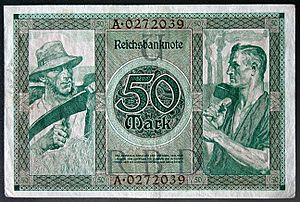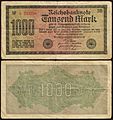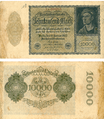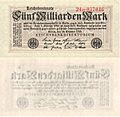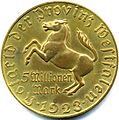German papiermark facts for kids
The German Papiermark was the official money used in Germany right after World War I, from 1919 to 1923. This period was known for a huge problem called hyperinflation, where prices for everyday things went up incredibly fast. Because of this, the Papiermark quickly lost its value. It was later replaced by the Rentenmark in November 1923, and then by the Reichsmark in 1924.
Contents
What Was the Papiermark?
The Papiermark became Germany's money after the German Empire ended and the Weimar Republic was formed. Before World War I, Germany's money was linked to gold (this was called the Gold standard). But when the war started in 1914, this link was removed. This meant the government could print more money without having enough gold to back it up.
The Problem: Hyperinflation
The biggest challenge with the Papiermark was hyperinflation. This is when money loses its value very, very quickly. Imagine a loaf of bread costing 1 Mark one day, and then 100 Marks the next, and then millions of Marks a few weeks later! This is what happened in Germany.
People needed huge amounts of money just to buy basic things. Workers would get paid twice a day and rush to spend their wages immediately, because by the end of the day, their money would be worth even less. Sometimes, the numbers on banknotes became so large that there wasn't enough space to print them, so words like "millions" and "billions" were used instead of just numbers.
Why Did Hyperinflation Happen?
Several things caused this extreme inflation:
- War Debts: Germany had borrowed a lot of money to pay for World War I.
- Reparations: After losing the war, Germany was ordered to pay huge amounts of money to other countries.
- Printing Too Much Money: To try and pay these debts and reparations, the German government printed more and more Papiermark. But printing more money without producing more goods just made the money worth less.
Bills of the Papiermark
As the Papiermark lost its value, the government had to print banknotes with increasingly larger numbers on them. This gallery shows how the denominations grew from thousands to billions in just a few years.
What Happened Next?
By late 1923, the Papiermark was almost worthless. To fix this, a new currency called the Rentenmark was introduced on November 15, 1923. One Rentenmark was equal to one trillion (1,000,000,000,000) Papiermark! This new money helped stabilize the German economy. In 1924, the Rentenmark was replaced by the Reichsmark, which became the official currency until after World War II.
Images for kids
See also
 In Spanish: Papiermark para niños
In Spanish: Papiermark para niños


